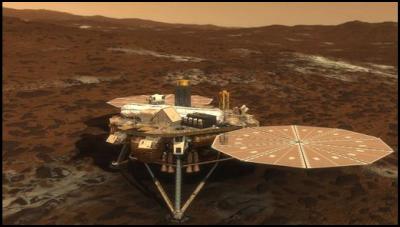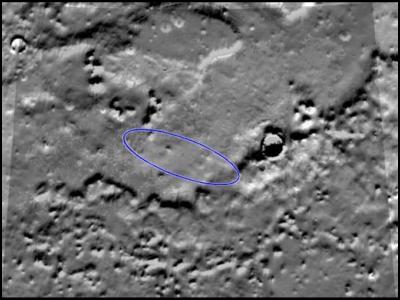Phoenix Mars Lander Prepares For Landing
PASADENA, Calif. -- NASA's Phoenix Mars Lander sped on Sunday morning toward its arrival at Mars, as the tug of the Red Planet's gravity accelerated the craft during the final day of its trip from Earth to Mars.
"Mars is literally pulling on our spacecraft, and at the same time it is pulling on our emotions," Phoenix Principal Investigator Peter Smith, of the University of Arizona, Tucson, said early Sunday afternoon. "We are excited at how close we are right now to beginning our study of a site where Martian water ice will be within our reach, after all these years of preparations. Our science mission begins as the spacecraft settles into its new home on Mars."

NASA's Phoenix Mars Lander will open its solar arrays 20 minutes after it touches down on the surface of Mars. This ensures that any dust kicked up during the landing will not settle in on the arrays.

Landing site on Mars.
The spacecraft's speed relative to Mars increased from 6,300 miles per hour at 8:30 a.m. Pacific Time to 8,500 mph at 12:30 p.m., headed for a speed higher than 12,000 mph before reaching the top of the Martian atmosphere.
Phoenix was on track for anticipated entry into the atmosphere at 4:30p.m. Pacific Time and reaching the surface at 4:38 p.m., although confirmation of those events comes no sooner than 15 minutes, 20 seconds later, due to the time needed for radio signals to travel from Mars to Earth.
Mission controllers decided Saturday night and Sunday morning to forgo the last two opportunities for adjusting the spacecraft's trajectory.
"We are so well on course that those adjustments were not necessary," said Phoenix Project Manager Barry Goldstein of NASA's Jet Propulsion Laboratory, Pasadena, Calif.
The most challenging part of the entire mission, getting from the top of the atmosphere to a safe landing on three legs, still lies ahead. Internationally, only five of the 11 attempts to land a spacecraft on Mars have succeeded.
The Phoenix mission is led by Smith, with project management at JPL. The development partnership is with Lockheed Martin, Denver. International contributions are from the Canadian Space Agency; the University of Neuchatel, Switzerland; the universities of Copenhagen and Aarhus, Denmark; the Max Planck Institute, Germany; and the Finnish Meteorological Institute.
For more about the Phoenix mission on the Web, visit: http://www.nasa.gov/phoenix.
ENDS


 UN News: Guterres Alarmed By Israeli Plans To Expand Gaza Ground Offensive
UN News: Guterres Alarmed By Israeli Plans To Expand Gaza Ground Offensive Caleb Fotheringham, RNZ Pacific: Poverty Persists Across PNG And Pacific Despite Economic Growth - World Bank
Caleb Fotheringham, RNZ Pacific: Poverty Persists Across PNG And Pacific Despite Economic Growth - World Bank 350.org: 350.org Pacific Reacts To Albanese Win In Australia Federal Elections
350.org: 350.org Pacific Reacts To Albanese Win In Australia Federal Elections Carbon Market Watch: Cookstove Carbon Credits: Recipe For Cooking The Climate Books
Carbon Market Watch: Cookstove Carbon Credits: Recipe For Cooking The Climate Books Reporters Without Borders: RSF Releases 2025 World Press Freedom Index
Reporters Without Borders: RSF Releases 2025 World Press Freedom Index PACER Plus: PACER Plus Joint Committee To Convene In Honiara For Critical Talks On Regional Economic Cooperation
PACER Plus: PACER Plus Joint Committee To Convene In Honiara For Critical Talks On Regional Economic Cooperation